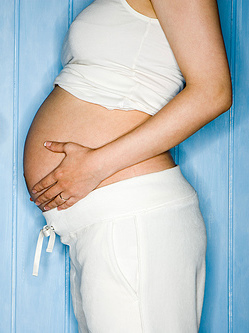Establishing correct neutral spine is fundamental to ensuring the length-tension relationship of the deep inner unit to enable its activation. Although pregnancy changes the centre of gravity, it should not change our thinking about the position of the pelvis or the need to maintain the fundamental patterns of movement.
I was recently asked by a yogalates teacher who attended my workshops whether:
“the pelvic patterns are safe and appropriate to do during pregnancy and if the core control breathing is too strong for them.”
She went on to say:
Alot of prenatal yoga teachers get the ladies to tuck the pelvis as the lower back is sometimes overarching to compensate for the belly, do you think widening the sit bones in neutral position which we use for correct spinal alignment is good for them?”
It’s great to see students reflecting on what I teach and how this can be applied to their work.
Due to the changes in the centre of gravity during pregnancy, the adaptive changes vary depending on the woman’s pre-natal biomechanics. One blanket rule for all pregnant women will never suffice, each woman needs to be assessed in terms of their particular function and/or dysfunction.
Pregnancy generally results in an increased lumbar lordosis, but the resulting impact differs according to the pre-natal bio-mechanics. Women presenting with a posterior crossed pelvic pattern prior to pregnancy will usually increase the lumbar lordosis, often exhibiting low back and pelvic pain due to increased eccentric load bearing through the lower lumbar vertebrae and pelvic girdle.
On the other hand, women presenting with an anterior crossed pelvic pattern pre-natally will also increase their lordosis, but this may in fact pull them into a more neutral position, often resulting in decreased pain or discomfort. The advice therefore is different and must reflect each woman’s changing biomechanics.
The objective is to establish neutral spine and maintain the fundamental patterns of movement, ensuring support from the deep inner unit. Feeling the sit-bones widen through movement is sound advice so long as there is support from the inner abdominal unit. It is the lack of abdominal strength and over recruitment of illio-psoas in the posterior crossed pelvic pattern that will cause the increased lordosis, coupled with over-engagement of the back extensors. Stretching the hip flexors and encouraging a neutral spine through movement will help reduce pain and discomfort for these women.
Breathing remains an essential component in establishing intra-abdominal pressure and has a positive soothing effect on the baby. As the baby grows and uterus begins to push up towards the diaphragm, making the diaphragmatic breath more difficult. However, without correct utilization of the diaphragm, activation of the deep inner unit is compromised.
Breathing practice and meditation are often used for birth preparation and are believed to soothe the baby. Ju Ju Sudin ( a pre-natal physiotherapist) in her book Birth Skills talks about ‘pushing the baby down’ using the breath. The visualization she encourages is that of pushing a grapefruit down with a coffee plunger on the inhalation. This analogy encourages the activation of the diaphragm against the resistance of the baby in breathing.
As a practitioner we also need to remain mindful of the biomechanics of the whole spine during treatment or exercise and be aware of what impact the upper thorax and neck are having on the clients dysfunction. If our client has difficulty engaging the diaphragm, accessory breathing muscles will be activated, resulting in increased stiffness of the upper thorax and overloading of the cervical spine.

Leave a Reply